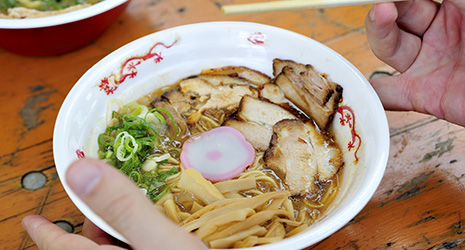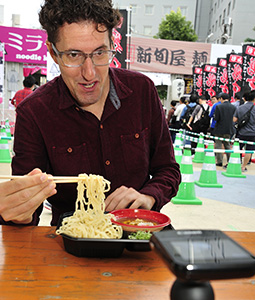Home > Highlighting JAPAN > Highlighting Japan November 2016 > Home Away from Home
Highlighting JAPAN


Fancy a Ramen?
Meet Brian MacDuckston.
Head bowed over his fifth bowl of the morning, Brian MacDuckston is slurping noodles and talking tsukemen. His audience: a video camera and thousands of subscribers to the blogger’s Ramen Adventures youtube channel.
MacDuckston and a small band of friends in noodles have gathered at a park in the Shinjuku district of Tokyo for Day 1, Week 2 of the Dai Tsukemen Haku festival. Here, over four weeks in October, twenty shops specializing in tsukemen would vie for diners’ affection against twenty shops serving ramen to determine the champion bowl. With the help of his friends, MacDuckston “crushed” and reviewed almost all forty bowls.
“Until a few years ago there was just one festival like this, the Tokyo Ramen Show, but now there are many around the country,” MacDuckston says. “They enable ramen restaurants to showcase their regular ramen or do something special. It’s another aspect of ramen.”
MacDuckston is a well known and respected contributor to Japan’s increasingly sophisticated ramen scene, in which the quest for superior ramen is continual and covered in a range of specialist ramen magazines, on TV and most dynamically through social media channels.
MacDuckston moved to Japan from San Francisco in 2006 and had his “first good ramen” in 2008, a foodie moment that inspired him to start his blog and later a youtube channel. MacDuckston’s blog today has followers in all corners of the world while his vlog posts regularly attract tens of thousands of views. MacDuckston’s review of the Michelin one-star Tsuta ramen restaurant for example has received close to 200,000 views. Half the hits to the blog come from overseas with popular posts such as those on ramen restaurant rankings suggesting that many readers are Japan-bound travelers looking for an unforgettable ramen experience while on these shores.
What’s big in ramen right now?
“When I started the blog, tsukemen was having its boom and a lot of shops were opening in Tokyo. Since then there have been many mini booms. The biggest one that has stuck is the trend for lighter, more refined soups. There’s a good example here today. Shinasoba Tanaka serves a really light shio [salt] ramen made with ocean ingredients. It’s really nice. Shio has been huge.”
Shinasoba Tanaka is an example of the new wave of artisanal ramen shops that have captured the imagination of restaurateurs and diners around the world with their umami-loaded broths, subtle blends of special seasonings and toppings so lovingly prepared that even a soft-boiled egg can make your eyes roll. As subscribers to the Ramen Adventures youtube channel will tell you, MacDuckston’s eyes are frequently seen to roll.
“In the past, ramen restaurants would often be messy, dirty places; women would never go there alone. That image has changed. Shops like Tanaka are super popular with women. It can be kind of fashionable to do ramen now.”
In addition to his media work, MacDuckston tours Japan with an English-language performance group entertaining children. “Over the course of the year we visit every single prefecture, so that’s one of the reasons why I’ve been able to review so many shops around the country. I get my recommendations from the Ramen Data Bank, restaurant review websites like Tabelog, ramen chefs and other ramen junkies like myself.”
MacDuckston often walks or rides his motorbike long distances to visit out-of-the-way ramen restaurants that have attracted rave reviews.
“It can be a really cool adventure to get out there. There are little towns that have their own ramen culture. Onomichi in Hiroshima Prefecture for example has thirty or forty shops devoted to the Onomichi style — a shoyu (soy sauce)-based ramen with a lot of seabura pork back fat in it. It’s a little city by the ocean with a huge ramen culture. People drive for an hour or more just to get in line to eat the ramen.”
MacDuckston introduces two ramen shops every week, though he may visit as many as ten depending on the number of ramen tours he conducts.
“A few years back when my site started getting popular I had a lot of interest from restaurateurs overseas wanting to hire me to take them around the shops. I’ve started offering that service to regular tourists as well. The tours are a good way for short-term visitors to sample the spectrum.”
MacDuckston regularly appears on TV and last year served as a judge at the Ippudo Ramen Competition, which has a 3 million yen top prize. His book, Brian’s Guide to 50 Great Tokyo Ramen Shops, is enjoying brisk sales.
Ten years in to his new life in Japan, MacDuckston, who has cut beer and bread from his diet to better indulge his passion, shows no sign of tiring of delicious ramen noodles.
“The thing I like most about ramen is its variety,” he says. “I’d get sick of eating the same thing all the time.”
© 2009 Cabinet Office, Government of Japan







